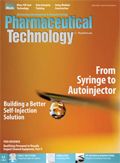News
Article
Pharmaceutical Technology
Qualifying Personnel to Visually Inspect Cleaned Equipment Part II: Small vs. Large Group Training
Author(s):
This article presents recommendations based on a program that was set up to qualify members of a large, diverse team at one oral solid-dosage-form manufacturing facility.
Monty Rakusen/Getty Images

Submitted: Sept. 14, 2015
Accepted: Oct. 2, 2015
Cleaned equipment must be visually inspected, both after cleaning and again before product manufacturing begins. Manufacturing and quality professionals must be qualified to do visual inspections. Small training groups are recommended for the training required, but a different approach can be used for larger groups. This article presents recommendations based on a program that was set up to qualify members of a large, diverse team at one oral solid-dosage-form manufacturing facility.
Both the European Eudralex (1) and the US Code of Federal Regulations (CFR) (2) require that cleaned pharmaceutical manufacturing equipment be visually inspected and determined to be clean, both after completion of the cleaning process and again immediately before manufacturing of the next batch or product begins. Visual inspection is designed to assess all of the visually accessible product contact surfaces of the pharmaceutical manufacturing equipment, and determine that the equipment is free from any visible residues. Manufacturing cannot begin until this assessment has been made, because it is crucial to patient safety and to verifying that the equipment has been adequately cleaned. A visual inspection is a routine part of cleaning and the first criterion for cleaning validation, and inspection results must be deemed acceptable before any swab samples can be collected from the cleaned equipment.
Visual inspections are conducted by a variety of site personnel. Equipment cleaning staff routinely inspect equipment during and after manual cleaning. A second person, in addition to the cleaning crew, must confirm and document visual cleanliness of cleaned equipment. Before manufacturing of the next batch of product can begin, manufacturing and quality staff must visually inspect all process equipment for cleanliness and document cleanliness in the manufacturing batch record. Quality and validation personnel also inspect cleaned equipment periodically as part of their work function.
Staffers responsible for conducting visual inspections have traditionally been trained by observing a seasoned employee perform this work. More experienced staffers would coach and advise them on issues or intricacies of the individual pieces of equipment, and then observe them when they conducted their own visual inspections. The approach worked, but could lead to subjectivity and inconsistent visual inspection results. Professionals at regulatory agencies believed that this approach could be improved if it were formalized and documented.
As part of a cleaning validation program, staff members who take swab samples have been routinely qualified to determine that they can adequately recover residues from equipment surfaces. Laboratory personnel are qualified to test the cleaning samples. Cleaning and testing procedures are validated to demonstrate consistent execution. Establishing a qualification criterion for the visual inspection of cleaned equipment is a logical extension of this philosophy that would improve cleaning validation and ensure that the training for all people who visually inspect cleaned equipment is objectively documented.
Training staffers in visual inspection poses a number of logistical challenges, however. Ideally, such training is done for small groups, within a laboratory setting (3). Qualifying a large, diverse group of personnel would be beneficial because it would provide a site with a routine, redundant, and rugged confirmation of the effectiveness of site cleaning procedures. Such training and qualification, however, is not practical in a laboratory setting.
At one oral solid-dosage-form manufacturing site, such a training program was offered to all operations and inspections staff. Due to the size and diverse schedules of members of this group, it proved to be more practical to bring the visual qualification testing to the personnel in the manufacturing area. Qualification was conducted using spiked coupons, and, because the coupons were spiked with formulations that contained API, for safety reasons, the qualification was conducted in an empty suite in the manufacturing area rather than a meeting room.
The site did not have visible residue limits (VRLs) established for its product portfolio. Rather than expend the time and resources required to establish the product VRLs, the company decided to spike coupons with the formulation at two levels only. One coupon was spiked at the acceptable residue limit (ARL) for the compound, and a second coupon was spiked at 50% of the ARL.It was reasoned that, if personnel could see the two spiked coupons, then they would be qualified to distinguish visually soiled equipment before it became a cleaning failure based on the ARL. By spiking coupons at 50% of the ARL, there would be a margin of safety between the visual level detected and a cleaning failure against the ARL. The choice of spiking at the 50% ARL level was a compromise between spiking at as low a level as practical while assuring personnel had the best opportunity to detect the residues visually.
Small group logistics
Training and qualification for visual inspection for small groups was discussed in a previous article (3). There are a number of options for presenting the spiked coupons, including presenting just the VRL levels or several spike levels down to the VRL. The former option uses fewer coupons but requires additional training to reduce the risk of qualification failure. The latter approach uses more coupons but has a lower risk of failure, and offers a more thorough approach that provides a greater understanding of visual inspection parameters.
Neither option, however, works well to train and qualify a large group. Qualification using just the VRL levels requires extensive up-front training to acquaint personnel with the appearance of residues at their VRL levels. Qualification using several spike levels down to the VRL would require more time for each individual of the large group to understand the concepts of visual inspection parameters. The use of more coupons might prevent the opportunity to spike and present all site residues for qualification during one training session, which would lengthen the time required for qualification.
Large group logistics
Training and qualification for visual inspection for a large group were subject to several practical constraints to qualify all personnel most efficiently and minimize disruption of ongoing operations. Three shifts were trained; therefore, training sessions were held at the end or beginning of the shift. One large group training session was held for each shift to familiarize personnel with the concepts and goals of the training and qualification exercise. A knowledge assessment was conducted with each group to confirm its grasp of the training concepts.
Visual inspection qualification was conducted in one of the manufacturing suites with more limited space. Space in which to view the spiked coupons was also limited. Therefore, smaller groups of 5-10 were brought in to observe the spiked coupons. The small groups were qualified either after their shift completed or during their shift, as job duties allowed. Once the groups were assembled, additional instructional training was conducted prior to the qualification to emphasize the effects of the viewing parameters, especially the viewing angle, the condition of the coupon surface, and the relative appearance of the spiked residues.
Qualification parameters
A survey of manufacturing equipment at the site concluded that all equipment surfaces could be visually inspected from a distance of 10 feet or less. The light levels measured in the manufacturing suites ranged from 725-1930 lux. The viewing angles of the equipment were only slightly restricted, but multiple viewing angles were possible for all cleaned equipment surfaces. The viewing parameters for the qualification were based on these findings.
Table I: Spiking levels for visual inspection qualification.
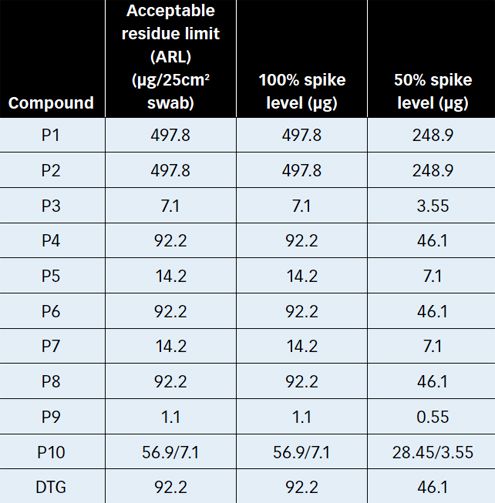
The material of construction (MOC) for the visual inspection qualification was stainless steel, the most prevalent MOC at the site. Residues for visual inspection qualification included all products manufactured at the site. Each residue was spiked at 100% and 50% of the ARL as shown in Table I and Figure 1. The residues tested for the visual inspection qualification showed that the qualified inspector should be able to visually detect residues on the manufacturing equipment during a visual inspection both after cleaning and again before manufacturing.
Figure 1: Visual inspection qualification using acceptable residue limit (ARL) levels. DTG is detergent.
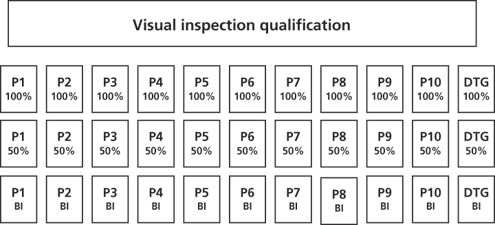
For viewing, coupons were presented on a table and positioned at a 15º-20º angle so that, when viewed at 10 feet, the minimum viewing angle for the coupons was greater than or equal to 30º. Staffers in the training program first viewed the coupons at two feet, where they were acquainted with the appearance of the residues and the effect on stainless steel. The grain of the stainless steel had little impact on their ability to see the easily visible residues, but had a more significant impact on how easily they could detect residues that were more difficult to see (e.g., the detergent). Personnel were also instructed on the effects of the viewing distance and the viewing angle.
After recording observations at two feet and 90º, trainees moved into a position at five feet with a 60º viewing angle to repeat the observations, and then moved back 10 feet at a 30º viewing angle. The ambient light level in the suite was 950 lux and, based on past ruggedness work (4), this was deemed suitable for light levels down to 200 lux. Trainees responded whether or not they were able to see the 100% and 50% ARL level residues.
Training
Qualification for visual inspections of cleaned equipment is just one part of the training required to assure reliable, thorough visual inspection of cleaned pharmaceutical manufacturing equipment. As shown in Table II, adequate training should start with a review of the standard operating procedures (SOPs) for visual inspection and visual inspection qualification, which describe the process for inspection and documentation of cleaned equipment, and the visual inspection qualification process. If available, equipment diagrams showing dimensions and swab locations with associated justification should be reviewed to familiarize trainees with the manufacturing equipment and problem areas for cleaning.
Table II: Training for visual inspection qualification.SOP is standard operating procedure.
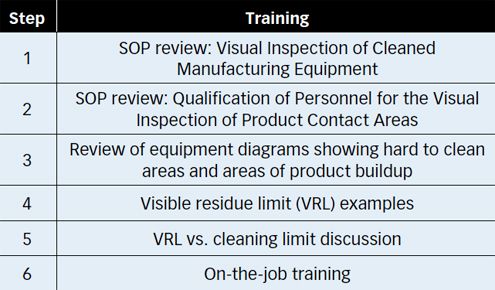
Before they can be qualified, each staff member must be trained in how to determine VRLs of different types so that they can detect low levels of residues for cleaning. It is a good idea to discuss the relationship of the VRL to the cleaning limit or ARL, and to clarify the relationship between the cleanability of the different residues from various MOCs. This clarification would help impart an understanding of the confidence level in the cleaning procedure and the visual inspection.
On-the-job training should consist of a supervised inspection of the manufacturing equipment, including the hard-to-clean locations and those most likely to have product buildup, for each piece of cleaned equipment identified for cleaning validation. The final step, after training and qualification, should consist of a monitored visual inspection of a cleaned piece of equipment, ensuring that the proper procedures are followed, a thorough visual inspection is conducted for the equipment, and the visual inspection is properly documented.
These aspects of training required considerably more time with a large group. Training consisted of a group session for each shift and then, as each small group was brought in for qualification, a short (three-to-five-minute) discussion of the viewing parameters, the residues and their appearance was completed at the two-feet distance. The risk for the abbreviated training was that some trainees might not sufficiently understand the importance of the viewing parameters or the significance of the training for their day-to-day jobs, and that they might misidentify coupons.
Experimental
Individual formulations were suspended into organic or aqueous solvents and diluted as necessary to obtain concentrations at five times the ARL level. To obtain the 100% ARL level, 200µL of the stock solutions were spiked onto individual coupons; to obtain the 50% ARL level, 100µL of the stock solutions were spiked onto individual coupons. The ARL spike levels of the 11 residues are shown in Table I. The cleaning residue limits ranged from 1.1 µg/swab up to 497.8 µg/swab. Blank coupons spiked with solvent were also prepared.
The spiked and blank coupons were arranged for qualification in a manufacturing suite, the light level was measured, viewing distances were marked, and small group subsets of the large group were brought in for additional instruction and qualification.
Qualification acceptance criteria
The logical acceptance criteria for visual inspection qualification are that all personnel identify all of the spiked coupons as “visible,” and all of the blank coupons as “blank.” Realistically, with a large group, the risk of misidentification of a coupon is more likely. For a blank coupon, a misidentified coupon would not necessarily have to be considered a failure. A blank coupon deemed visible is a mistake on the side of caution and could be tolerated. If a spiked coupon is not identified as such, it is more problematic. Potentially, a visually soiled piece of equipment could be deemed as clean and released for subsequent manufacturing. The equipment could be used to manufacture a different product, which could be cross-contaminated. Or the visible residue on the equipment could be identified during redundant visual inspections, either by quality assurance personnel (QA) or before the next batch. In either case, the equipment would need to be re-cleaned and an investigation would need to be launched to identify the root cause of the visual failure. Both options could cause problems for the site.
As a result of the accepted risk of abbreviated training, the qualification resulted in misidentification of spiked coupons for a small percentage (<5%) of the trainees.
Results and discussion
The visual inspection qualification for a large group presents several logistic and timing challenges. Processing a large group requires a fair amount of time and must be conducted in an area with sufficient space. In-depth training for VRLs and viewing parameters, although preferable, is neither practical nor does it add sufficient value. It is also more difficult to gauge the effectiveness of training in a large group environment. Therefore, a scaled-back, more expedient and efficient training program was implemented for large group qualification. This approach did not employ the true VRLs for production residues, but did assure that personnel could visually detect process residues prior to a cleaning failure based on the swab limit. The margin of safety between the lower residue level tested and the swab limit provided some measure of confidence that visually soiled equipment would not pass visual inspection. The majority of personnel were able to visually detect all residues within the viewing parameters, and any risk of inadequate visual inspection was mitigated by redundant visual inspection proceduralized at the facility.
Table III: Large group qualification results summary.
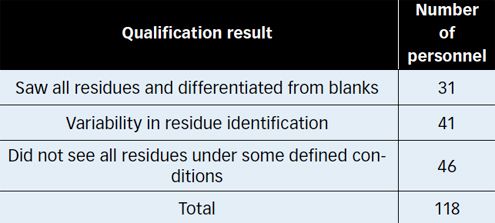
Results of the qualifications are summarized in Table III, and the individual residue results are shown in Table IV. Table III shows that a two-thirds majority were able to see the residues under the established viewing parameters, although there was some variability in a number of responses: the ability to see one of the spiked residues for a particular formulation while not seeing the other was the variation most often noted. Of the 46 observations where residues were not visually detected, the vast majority were for Product 7 and/or the detergent. Table IV provides a more detailed list of the number of personnel that were able to detect the individual residues. Eight of the 11 residues were visible out to 10 feet and beyond with less than a 5% standard deviation. Product 5 was not consistently visible at 10 feet but was visible at five feet. Of the 11 residues, the Product 7 formulation and the detergent were not consistently visible at all distances on a consistent basis.
Figure 2: Residues not visually detected by individual personnel.
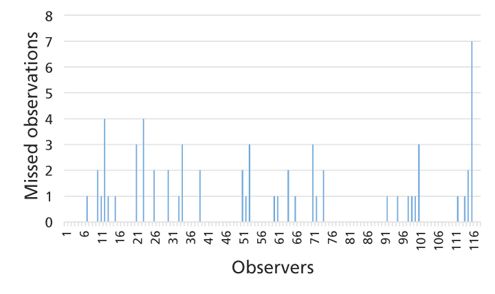
The detergent (DTG) results are not applicable unless a component of the detergent is identified for the cleaning limit because the results are based on the total weight of the detergent. The detergent is 66% water, which means that only 34% or 31.3 µg of total solids were spiked onto the 100% level coupon.
CLICK TABLE TO ENLARGE Table IV: Large group qualification results, 18 personnel. DTG is detergent. ARL is acceptable residue limit.

The individual personnel results were examined for consistency and to determine if there were any individuals who had a particular problem visually detecting residues. The results for Product 7 and the detergent were ignored because they were difficult to detect for a large number of personnel. The results of the individual analysis are shown in Figure 2. One individual missed the visible residue on seven coupons, suggesting that he or she either be trained on the appearance of residues, encouraged to perform any visual inspection from two feet, or be excluded from signing off on visual inspections. Additional training might also be advised for the two individuals who missed the visible residue on four coupons and the five individuals who missed the visible residue on three coupons.
Conclusion
A large group of personnel were successfully qualified for visual inspection of cleaned equipment at an oral solid-dose manufacturing facility. The qualification was implemented for all products made at the facility and conducted within the time and space constraints of the production schedule.
The visual inspection procedure for a large personnel group were considered qualified for Products 1-4, 6, 8, 9, and 10 for a light level of > 200 lux; a viewing distance of < 10 ft; and a viewing angle of > 15º. The visual inspection procedure is appropriate to verify cleaning process effectiveness to acceptably remove formulation residues from equipment during cleaning validation and routine monitoring. The visual inspection procedure was considered qualified for Product 5 for a light level of > 200 lux; a viewing distance of < 5 ft; and a viewing angle of > 15º. Equipment cleaned after manufacture of Product 7 formulations should be viewed from as close a distance as practical using multiple angles under ambient light (> 200Lux) to provide the highest confidence of visually detecting any remaining formulation. Trainees who had difficulty visually detecting the spiked residues could receive additional training on the appearance of the residues and be retested. In this case, the risk of visually soiled equipment passing visual inspection is mitigated by validation of the respective cleaning procedures, by the restricted viewing parameter limitations (e.g., five feet) for specific residues and by the redundant visual inspection immediately after cleaning by the equipment cleaner, the confirmatory inspection after cleaning and the visual inspection immediately prior to the subsequent manufacturing.
Risk could be further mitigated or eliminated by adding training using spiked coupons prior to the qualification exercise. This would acquaint personnel with the viewing parameters and their effect on the ability to visually detect spiked residues. This could be done with the entire large group but would probably be more effective with each small group prior to qualification. The small group training could be done immediately prior to qualification using an additional trainer and would extend the entire process by an additional 10-15 minutes.
Qualification of personnel for visual inspection of cleaned pharmaceutical manufacturing equipment product contact surfaces is a necessary complement to both a cleaning validation program and the manufacturing operations at a site. Visual inspection qualification is just one facet of an overall training program to assure that personnel are equipped to provide a consistent, thorough and accurate evaluation of cleaned surfaces for ongoing pharmaceutical operations.
References
1. EMA, Eudralex, Volume 4, EU Guidelines for Good Manufacturing Practice for Medicinal Products for Human and Veterinary Use, Annex 15: Qualification and Validation, Section 10.2
2. FDA, Code of Federal Regulations, Title 21, Food and Drugs (Government Printing Office, Washington, DC), Part 211.67
3. R. J. Forsyth, Pharm. Technol. 38 (1), 42 - 46 (2014)
4. R. J. Forsyth, Pharm. Technol. 33 (3), 102-111 (2009).
Article DetailsPharmaceutical Technology
Vol. 40, No. 6
Pages: 34â38
Citation
When referring to this article, please cite it as R. Forsyth, "Qualifying Personnel to Visually Inspect Cleaned Equipment Part II: Small vs. Large Group Training," Pharmaceutical Technology 40 (6) 2016.
Newsletter
Get the essential updates shaping the future of pharma manufacturing and compliance—subscribe today to Pharmaceutical Technology and never miss a breakthrough.
